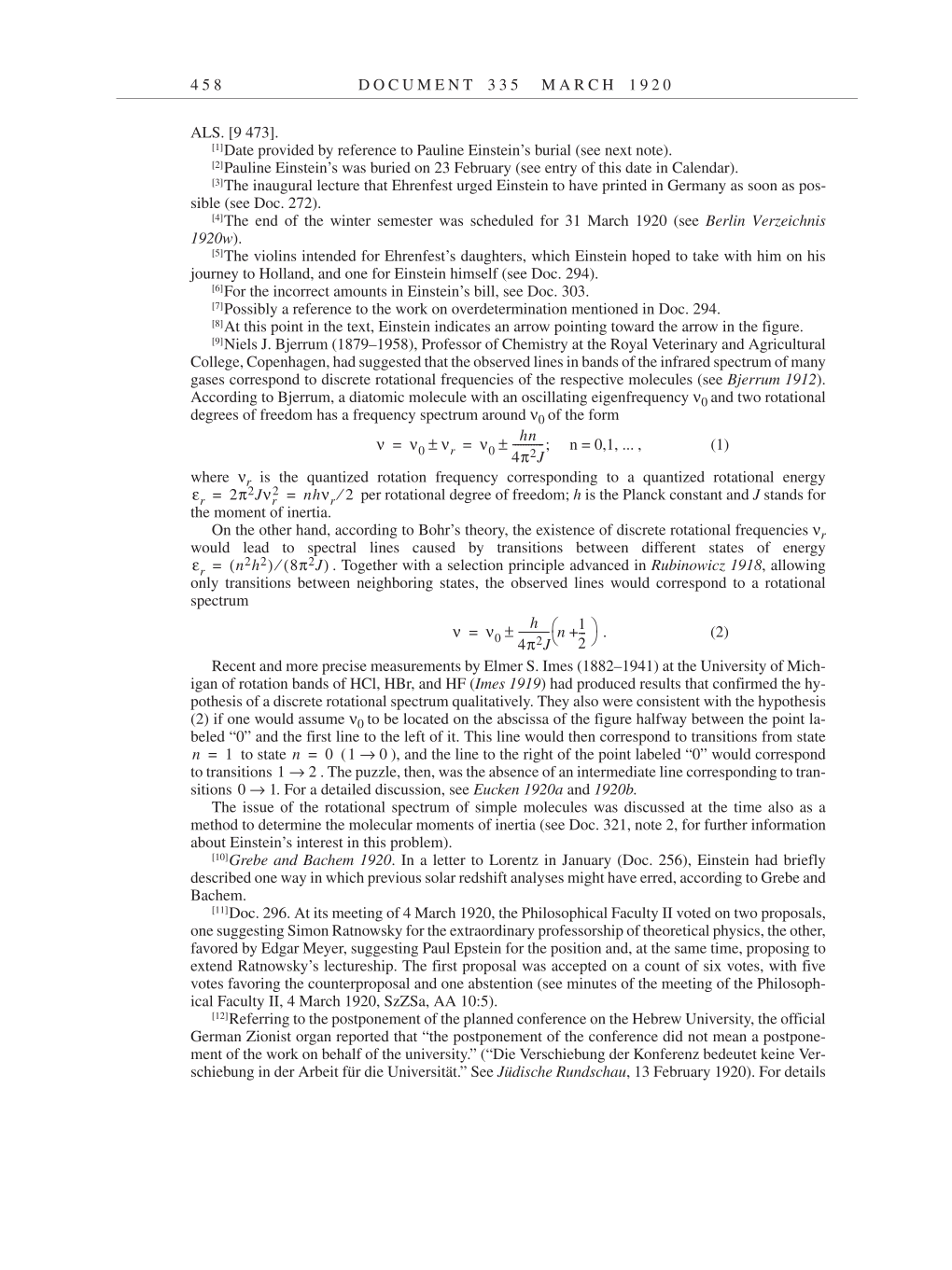4 5 8 D O C U M E N T 3 3 5 M A R C H 1 9 2 0
ALS. [9 473].
[1]Date provided by reference to Pauline Einstein’s burial (see next note).
[2]Pauline Einstein’s was buried on 23 February (see entry of this date in Calendar).
[3]The inaugural lecture that Ehrenfest urged Einstein to have printed in Germany as soon as pos-
sible (see Doc. 272).
[4]The end of the winter semester was scheduled for 31 March 1920 (see Berlin Verzeichnis
1920w).
[5]The violins intended for Ehrenfest’s daughters, which Einstein hoped to take with him on his
journey to Holland, and one for Einstein himself (see Doc. 294).
[6]For the incorrect amounts in Einstein’s bill, see Doc. 303.
[7]Possibly a reference to the work on overdetermination mentioned in Doc. 294.
[8]At this point in the text, Einstein indicates an arrow pointing toward the arrow in the figure.
[9]Niels J. Bjerrum (1879–1958), Professor of Chemistry at the Royal Veterinary and Agricultural
College, Copenhagen, had suggested that the observed lines in bands of the infrared spectrum of many
gases correspond to discrete rotational frequencies of the respective molecules (see Bjerrum 1912).
According to Bjerrum, a diatomic molecule with an oscillating eigenfrequency ν0
and two rotational
degrees of freedom has a frequency spectrum around ν0 of the form
, (1)
where νr is the quantized rotation frequency corresponding to a quantized rotational energy
per rotational degree of freedom; h is the Planck constant and J stands for
the moment of inertia.
On the other hand, according to Bohr’s theory, the existence of discrete rotational frequencies νr
would lead to spectral lines caused by transitions between different states of energy
. Together with a selection principle advanced in Rubinowicz 1918, allowing
only transitions between neighboring states, the observed lines would correspond to a rotational
spectrum
. (2)
Recent and more precise measurements by Elmer S. Imes (1882–1941) at the University of Mich-
igan of rotation bands of HCl, HBr, and HF (Imes 1919) had produced results that confirmed the hy-
pothesis of a discrete rotational spectrum qualitatively. They also were consistent with the hypothesis
(2) if one would assume ν0 to be located on the abscissa of the figure halfway between the point la-
beled “0” and the first line to the left of it. This line would then correspond to transitions from state
to state ( ), and the line to the right of the point labeled “0” would correspond
to transitions . The puzzle, then, was the absence of an intermediate line corresponding to tran-
sitions For a detailed discussion, see Eucken 1920a and 1920b.
The issue of the rotational spectrum of simple molecules was discussed at the time also as a
method to determine the molecular moments of inertia (see Doc. 321, note 2, for further information
about Einstein’s interest in this problem).
[10]Grebe and Bachem 1920. In a letter to Lorentz in January (Doc. 256), Einstein had briefly
described one way in which previous solar redshift analyses might have erred, according to Grebe and
Bachem.
[11]Doc. 296. At its meeting of 4 March 1920, the Philosophical Faculty II voted on two proposals,
one suggesting Simon Ratnowsky for the extraordinary professorship of theoretical physics, the other,
favored by Edgar Meyer, suggesting Paul Epstein for the position and, at the same time, proposing to
extend Ratnowsky’s lectureship. The first proposal was accepted on a count of six votes, with five
votes favoring the counterproposal and one abstention (see minutes of the meeting of the Philosoph-
ical Faculty II, 4 March 1920, SzZSa, AA 10:5).
[12]Referring to the postponement of the planned conference on the Hebrew University, the official
German Zionist organ reported that “the postponement of the conference did not mean a postpone-
ment of the work on behalf of the university.” (“Die Verschiebung der Konferenz bedeutet keine Ver-
schiebung in der Arbeit für die Universität.” See Jüdische Rundschau, 13 February 1920). For details
ν ν0 νr ± ν0
hn
4π2J
----------- -; n = 0,1, ... ± = =
εr 2π2Jνr 2 nhνr 2 ⁄ = =
εr n2h2) ( 8π2J) ( ⁄ =
ν ν0
h
4π2J⎝
-----------
-⎛
n
1
2
- +--
⎠
⎞
± =
n 1 = n 0 = 1 0 →
1 2 →
0 1. →
